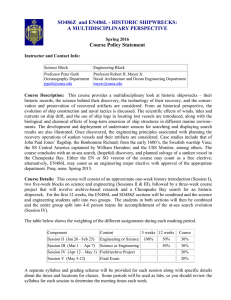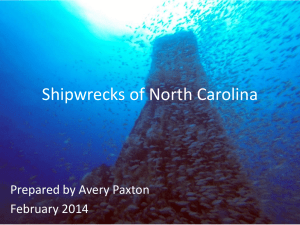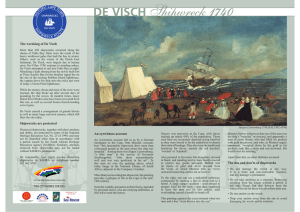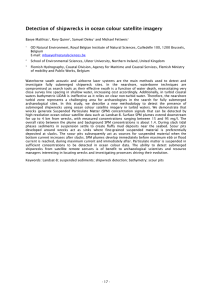Cultural Resource Management of Shipwrecks by Jack B. Irion, Ph.D.
advertisement
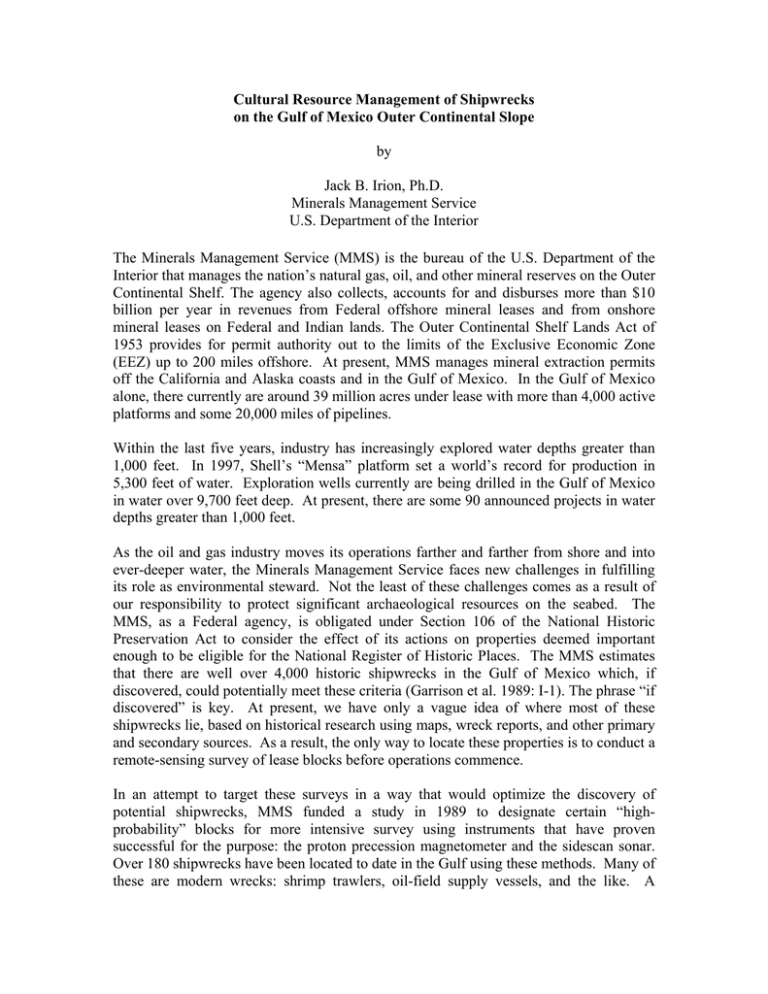
Cultural Resource Management of Shipwrecks on the Gulf of Mexico Outer Continental Slope by Jack B. Irion, Ph.D. Minerals Management Service U.S. Department of the Interior The Minerals Management Service (MMS) is the bureau of the U.S. Department of the Interior that manages the nation’s natural gas, oil, and other mineral reserves on the Outer Continental Shelf. The agency also collects, accounts for and disburses more than $10 billion per year in revenues from Federal offshore mineral leases and from onshore mineral leases on Federal and Indian lands. The Outer Continental Shelf Lands Act of 1953 provides for permit authority out to the limits of the Exclusive Economic Zone (EEZ) up to 200 miles offshore. At present, MMS manages mineral extraction permits off the California and Alaska coasts and in the Gulf of Mexico. In the Gulf of Mexico alone, there currently are around 39 million acres under lease with more than 4,000 active platforms and some 20,000 miles of pipelines. Within the last five years, industry has increasingly explored water depths greater than 1,000 feet. In 1997, Shell’s “Mensa” platform set a world’s record for production in 5,300 feet of water. Exploration wells currently are being drilled in the Gulf of Mexico in water over 9,700 feet deep. At present, there are some 90 announced projects in water depths greater than 1,000 feet. As the oil and gas industry moves its operations farther and farther from shore and into ever-deeper water, the Minerals Management Service faces new challenges in fulfilling its role as environmental steward. Not the least of these challenges comes as a result of our responsibility to protect significant archaeological resources on the seabed. The MMS, as a Federal agency, is obligated under Section 106 of the National Historic Preservation Act to consider the effect of its actions on properties deemed important enough to be eligible for the National Register of Historic Places. The MMS estimates that there are well over 4,000 historic shipwrecks in the Gulf of Mexico which, if discovered, could potentially meet these criteria (Garrison et al. 1989: I-1). The phrase “if discovered” is key. At present, we have only a vague idea of where most of these shipwrecks lie, based on historical research using maps, wreck reports, and other primary and secondary sources. As a result, the only way to locate these properties is to conduct a remote-sensing survey of lease blocks before operations commence. In an attempt to target these surveys in a way that would optimize the discovery of potential shipwrecks, MMS funded a study in 1989 to designate certain “highprobability” blocks for more intensive survey using instruments that have proven successful for the purpose: the proton precession magnetometer and the sidescan sonar. Over 180 shipwrecks have been located to date in the Gulf using these methods. Many of these are modern wrecks: shrimp trawlers, oil-field supply vessels, and the like. A number of historically significant shipwrecks also have been found, some at scuba-diving depths. These include the sidewheel steamship New York (1846) (Irion and Ball 2001), the USS Hatteras (1863) (Arnold and Anuskiewicz 1995), the Josephine (1881) (Irion and Ball 2001), and nearly a dozen casualties from World War II. The process on the relatively shallow waters of the shelf has been as follows. In blocks designated as having a high potential for shipwrecks, the lessee is required to conduct a high-resolution survey using a boat-towed magnetometer, a sidescan sonar, a subbottom profiler, and a fathometer. These surveys differ from normal shallow hazard surveys only in the fact that they are conducted along tracklines spaced 50 meters (165 feet) apart instead of 300 meters (990 feet) apart. The premise of the high-probability block model was based on the idea that historic shipwrecks would likely be found within 10 miles of their historically reported positions. Unfortunately, this has not proven to be entirely accurate. Over the past ten years, a number of important wrecks have been found many miles away from their reported position and outside of the 9-block grid designated for their search. This is caused by a number of factors, mostly relating to the general vagueness of historic wreck reporting. Many historic wrecks were recorded simply as “lost between Galveston and New Orleans” or “sunk 35 miles south the Sabine River.” Even the recorded positions of relatively recent World War II wrecks are woefully inaccurate. Many of the wrecks that have been discovered in oil and gas industry surveys were located by sidescan sonar using standard shallow hazard survey methods despite being outside the archaeology high-probability survey grid. In fact, the routine use of sidescan for shallow-hazard surveys outside of any lease area designated for archaeological survey has given us something of a comfort factor for those areas beyond the 60-meter depth contour, where archaeological survey was not required. As a result of industry’s use of the deep-tow sonar, 16 shipwrecks have been located in water depths greater than 1,000 feet (Table 1). Again, all of these ships lay outside of the 9-block grids designated for their search from our historical research. Table 1. Discovered Vessels in Deep Water. Vessel Name Area Unknown Unknown Unknown Unknown Unknown Gulfoil Unknown Unknown Unknown Unknown Green Canyon Mississippi Canyon Mississippi Canyon Garden Banks Garden Banks Mississippi Canyon Mississippi Canyon Viosca Knoll East Breaks East Breaks Wreck Date ? ? ? ? ? 1942 ? ? ? ? Min Depth of Block (m) 802 315 572 441 622 1209 1163 1250 1109 967 Max Depth of Block (m) 965 519 784 592 900 1359 1231 1427 1144 1224 Vessel Name Area Unknown Alcoa Puritan Gulfpenn U-166 Mica Wreck Garden Banks Mississippi Canyon Mississippi Canyon Mississippi Canyon Mississippi Canyon Robert E. Lee Mississippi Canyon Wreck Date ? 1942 1942 1942 ca. 1800 1942 Min Depth of Block (m) 1062 1870 455 1399 743 Max Depth of Block (m) 1146 2000 578 1642 932 1399 1642 The difficulties associated with locating shipwrecks become exacerbated as industry moves farther offshore and into deeper water. Historical estimates of location based on dead reckoning become exaggerated and the likelihood of survivors to report the wreck decreases. In very deep water, the drift of the vessel through the water column for a mile or more can result in a large discrepancy between the reported position when the vessel began sinking on the surface to its final resting-place on the ocean floor. The great uncertainty associated with historic shipwreck positions, coupled with the current trend towards replacing standard high-resolution geophysical survey in deep water with 3-D seismic imaging, is forcing MMS to re-think its approach to Section 106 compliance in the face of the steady advance into deepwater areas. At present, MMS estimates that there are at least 35 historic shipwrecks in the Gulf of Mexico in water depths greater than 1,000 feet (Table 2). These vessels range in date from 1752 to 1942, and include several merchant ships lost to U-boat attacks, such as the Ontario, the Torny, the Ampala, the Carabelle, the Gulfpenn, and the Gulfoil. The majority of the reported losses, however, are schooners ranging from 300 to just over 1,000 tons that foundered in the late nineteenth and early twentieth century. Table 2. Reported Shipwrecks in Deep Water. Vessel Name Wreck Date Rhoda B. Taylor Marion N. Cobb Walter L. Plummer B-1 James C. Clifford Villa y Hermano Springfield Ontario C.W. Wells Northern Eagle Helena E. Russel William J. Keyser Emma L. Cottingham 1878 1925 1894 1942 1909 1905 1918 1942 1921 1908 1899 1898 1906 Min Depth of Search Area (m) 368 1421 282 889 258 669 1083 2495 770 246 799 296 1046 Max Depth of Search Area (m) 439 2321 335 1061 525 810 1398 2743 1006 483 1195 487 3230 Vessel Name Wreck Date Rhoda B. Taylor Allegheny Torny Biscayne Rosetta McNeil Fred P. Litchfield Horace M. Bickford Speedwell Providencia Isaac T. Campbell Three Marys J.W. Clise W.H. Marston Ampala Carabelle Carrie Strong Nokomis Western Empire Gulfpenn (see Table 1) Gulfoil (see Table 1) Elmer E. Randall Anona Bradford C. French 1878 1921 1942 1913 1882 1906 1925 1920 1936 1909 1920 1940 1927 1942 1942 1916 1905 1875 1942 1942 1906 1944 1916 Min Depth of Search Area (m) 368 2985 3032 3159 3180 3008 3292 2888 2906 2995 2792 2637 2601 2825 2966 2773 2220 978 426 381 250 378 709 Max Depth of Search Area (m) 439 3051 3118 3219 3219 3082 3322 2926 2999 3072 2890 2762 2787 2918 3033 2883 2579 2171 720 757 1042 1321 1497 It is important to emphasize that this list represents only those vessels in deepwater and of which we are aware from historical records. Many times these numbers of vessels were merely lost at sea with no approximate location given because there were no survivors left to report the loss. A perfect example of this situation occurred when one operator discovered, during his post-lay remotely-operated vehicle (ROV) survey, that he had laid his pipeline through the middle of a previously unknown 200-year old shipwreck in over 2,600 feet of water. (In this case, the pipeline route had been surveyed using a 100-kHz sidescan, but the line spacing was inadequate to provide 100-percent coverage of the centerline.) As a result, the operator was required to fund a data recovery investigation that will begin in summer 2002 to mitigate the damage. If industry were routinely conducting high-resolution sonar surveys with good coverage of their lease blocks, MMS would have a fair degree of confidence that many of these wrecks would be discovered even if they fell outside of an “official” archaeological survey area. However, because of the high cost of conducting high-resolution surveys in deep water (around $300,000 per 9-mile2 lease block), the current trend is to utilize 3-D seismic data in hazard analyses in areas without complex bottom topography. Unlike high-resolution survey instruments, whose sensors must be towed close to the seafloor, 3D seismic instrumentation consists of streamers and airgun arrays towed just below the surface. A typical survey boat tows nine streamers that can be up to 12 kilometers in length. An air gun or sparker (40-250 Hz) is usually used for deep penetration to 10003000 feet below the seafloor. Three-dimensional seismic technology has proven to be a real boon to the oil and gas industry in the Gulf, primarily because it permits, for the first time, accurate definition of reserves beneath salt domes, which act as a barrier to traditional 2-D imaging. With proper post-processing, 3-D data also have proven useful in mapping surface faults, vents, and other “geological hazards.” As a result, MMS biologists are using these data to predict the location of chemosynthetic tubeworms (Roberts et al. 2000). It would be serendipitous if 3-D seismic data could also be used to locate shipwrecks, since these data are routinely acquired in deepwater lease blocks. Unfortunately, though, this does not appear likely, based upon our analysis of two test cases. As discussed earlier, two important wrecks have already been discovered in Mississippi Canyon Area in nearly 5,000 feet of water using the deep-tow sonar. One of these wrecks, the passenger steamer Robert E. Lee, is quite large with substantial remains showing above the seafloor. The German submarine U-166 torpedoed the passenger ship SS Robert E. Lee on July 30, 1942, while in route from Trinidad to New Orleans. At the time of her loss, her compliment consisted of 131 crewmembers, 6 Naval Armed Guard, and 270 passengers, most of whom were survivors of other torpedoed American ships. Ten crewmembers and 15 passengers were lost. The Robert E. Lee was built in 1924 and was 375 feet long with a 54-foot beam and a gross tonnage of 5,184. The sidescan image of the wreck shows it to be largely intact and upright on the seafloor with a relief off the seabed of over 60 feet. The German submarine U-166, located a short distance away in the same lease block, was identified during a pipeline survey in May 2001 using a high-resolution sonar mounted in a Hugin 3000 autonomous underwater vehicle (AUV). The same target had been observed in a previous deep-tow survey in 1986 but was incorrectly identified as the tanker Alcoa Puritan. The higher resolution sonar used in the AUV left little doubt as to the identification, which was subsequently confirmed by video from an ROV camera. The sub, the only one sunk in the Gulf of Mexico, was a Type IXc Unterseeboot (U-boat) and originally measured 76 meters (254 feet) long. After sinking the Robert E. Lee with a torpedo to its starboard aft quarter, the U-boat itself was sunk by the steamer’s U.S. Navy escort. Ironically, the U-166 had reportedly been sunk 130 miles to the west in less than 100 feet of water. Both of these steel-hulled wrecks are quite large, with substantial remains above the seafloor. The Robert E. Lee, in particular, appears largely intact in the sonar record. Moreover, accurate coordinates of both of these wrecks were obtained in 1986 and again in 2001. This permitted a line-by-line analysis of available 3-D data by MMS geophysicists for several hundred feet around both coordinates. Absolutely nothing was observed in these data that could distinguish either of these two large vessels from the surrounding seafloor. Table 3, showing the expected horizontal resolution for a typical 60-Hz array, illustrates quite clearly why even a large shipwreck in deepwater could go undetected (Stright et al. 2002:8). As a result, MMS is forced to conclude that 3-D seismic surveys are completely ineffective for the purpose of locating shipwrecks on the seafloor. Table 3. Horizontal Resolution of Seismic Data Water Depth (feet) 800 Horizontal Resolution (feet) 182.6 1,000 1,500 204.1 2,000 288.7 3,000 322.7 250 What then are the alternatives? At present, only instruments that can be deployed relatively close to the seafloor seem to provide sufficient resolution to detect even large shipwrecks. Traditionally, this has required a deep-tow sidescan sonar system, although recent advances in multibeam echosounder systems have also yielded spectacular results. The discovery this past year of the World War II casualty Alcoa Puritan produced images that in many ways are superior to those acquired by 100-kHz sidescan. The MMS frequently has waived the requirement for high-resolution survey in water depths greater than 1,000 feet outside of the limited number of archaeological highprobability areas. These waivers have typically been granted in areas where it is believed that there is not an over-riding engineering need for seafloor data that could affect the safety of the proposed project. This waiver is granted if the seafloor is relatively smooth with no faulting, shallow gas, or other seafloor hazards near the drilling location. In this case, 3-D seismic data have been accepted as an acceptable substitute for engineering purposes, and a visual inspection of the drilling area is made with an ROV as a precaution against damaging archaeological or biological resources. Pipeline construction, however, continues to be the driving force in deepwater surveys, since the potential for engineering hazards to a pipeline is far greater. A new technology, the autonomous underwater vehicle (AUV), will likely come to dominate this work in the near future. The AUVs currently in use in the Gulf can conduct a high-resolution survey along programmed routes and store the data on a hard drive until they can be downloaded on the mother ship after the vehicle is recovered (Chance et al. 2000). Since AUV’s are not towed by a boat, but operate independently, survey time and cost are greatly reduced. The AUVs now working in the Gulf have demonstrated that it is possible to survey five times faster and for one-half the cost of a traditional deep-tow system. In the meantime, more intensive historical research may help us to refine and improve our model of where shipwrecks are likely to occur in deep water and which of these wrecks might truly be of National Register significance. Why does MMS require industry to go to such effort to locate shipwrecks in deep water? The National Historic Preservation Act of 1966 was enacted to recognize that the nation is “founded upon and reflected in its historic heritage” (16 U.S.C. ss. 470 et seq., 470[b][1]). By passing this Act into law, Congress proclaimed that: The preservation of this irreplaceable heritage is in the public interest so that its vital legacy of cultural, aesthetic, inspirational, economic, and energy benefits will be maintained and enriched for future generations (16 U.S.C. s. 470[b][4]). Section 106 of the National Historic Preservation Act (NHPA) requires that Federal agencies take into account the effect of any proposed Federal, federally assisted, or federally licensed undertaking on any historic property that is included in, or eligible for inclusion in, the National Register of Historic Places. The other main provision of the NHPA is Section 110(a)(2), which requires Federal agencies to manage historical resources under their jurisdiction and control. Such management includes the obligation to survey, inventory, and determine the eligibility of historic properties for nomination to the National Register. There is no question that the OCS is under the jurisdiction and control of the Federal Government, beginning with the Truman Proclamation of 1945. The Submerged Lands Act of 1953 (43 U.S.C. Sec. 1301-1315) relinquished control of a portion of the continental shelf to the states. Section 1301(b) provides for retention by the United States of its rights, including jurisdiction and control, beyond those areas over which State control was established (Lingren 1975). The OCS Lands Act of 1953, 43 U.S.C. Sections 1331-1343, empowered the Secretary of the Interior to authorize the exploration for and development or removal of deposits of oil, gas, and other minerals. However, as a result of a ruling by the Fifth District Court in the Atoche case, it was determined that the Antiquities Act of 1906, 16 U.S.C. Section 431, et seq., could not be used in conjunction with the OSCLA to assert ownership over historic shipwrecks in Federal waters (Treasure Salvors 1978). Despite the Atoche ruling, the applicability of NHPA to MMS actions was re-affirmed in a memorandum from the Office of the Solicitor dated June 19, 1978, stating: “the United States has adopted a policy of protecting cultural resources located on the Outer Continental Shelf, and that the Department has the requisite statutory mandate to see that Federally authorized offshore oil and gas operations do not unnecessarily jeopardize the existence or condition of cultural resources situated within an area covered by an OCS oil and gas lease.” As a result, MMS has pursued a policy, first through lease stipulation and then through regulation (30 CFR 250.194) of requiring that lessees do not “unnecessarily jeopardize or harm a cultural resource which has been identified or is believed to exist.” At present, no other historic preservation legislation applies to shipwrecks on the Outer Continental Shelf (Varmer and Blanco 1999). The Abandoned Shipwreck Act (43 U.S.C. ss. 2101-2106 [effective 28 April 1988]) is applied only to State waters, the National Marine Sanctuary Act (16 U.S.C. s. 1431, et seq.) only protects shipwrecks in National marine sanctuaries, and the Antiquities Act (16 U.S.C. s. 431, et seq.) is limited to marine protected areas, such as national seashores. Arnold, J. Barto III and Richard J. Anuskiewicz 1995 USS Hatteras: Site Monitoring and Mapping, Underwater Archaeology Proceedings from the Society for Historical Archaeology Conference, Paul F. Johnston, ed. Washington, DC. Chance, Thomas S., Art A. Kleiner, and Jay G. Northcutt. 2000 The Autonomous Underwater Vehicle (AUV): A Cost-Effective Alternative to Deep-Towed Technology, Integrated Coastal Zone Management, Vol.I, pp. 65-71. Garrison, E. G., C.P. Giamona, F.J. Kelly, A.R. Tripp, and G.A. Wolf. 1989 Historic Shipwrecks and Magnetic Anomalies of the Northern Gulf of Mexico. 3 vols. Prepared for the U.S. Department of the Interior, Minerals Management Service, OCS Study MMS 89-0023. Irion, Jack B. and David A. Ball 2001 The New York and the Josephine: two steamships of the Charles Morgan Line, The International Journal of Nautical Archaeology Vol. 30.1:48-56. Lingren, David E., Letter to Walter Keichel, Jr., 1975 Acting Assistant Attorney General from the Office of the Solicitor, United States Department of the Interior, November 4, 1975. Roberts, H., J. Coleman; J. Hunt, Jr., and W.W. Shedd. 2000 Improving interpretation of seafloor geology, biology from remote sensing, Offshore Vol. 60, No. 9, pp. 126-128, 181. SHA Newsletter 2001 UNESCO Underwater Heritage Convention Adopted. Vol. 34.4: 21. Stright, Melanie, Gregory Boland, Michael Celata, Jack Irion, Robert Kuzela, Robert W. Smith, and Nick Wetzel 2002 Deepwater Survey Team Report. US Department of the Interior, Minerals Management Service, New Orleans. Treasure Salvors v. The Unidentified Wrecked and Abandoned Sailing Vessel, 569 F.2d 330 (5th Cir. 1978) Varmer, Ole and Caroline M. Blanco. 1999. United States of America, in Legal Protection of the Underwater Cultural Heritage: National and International Perspectives, Sarah Dromgoole, ed.
